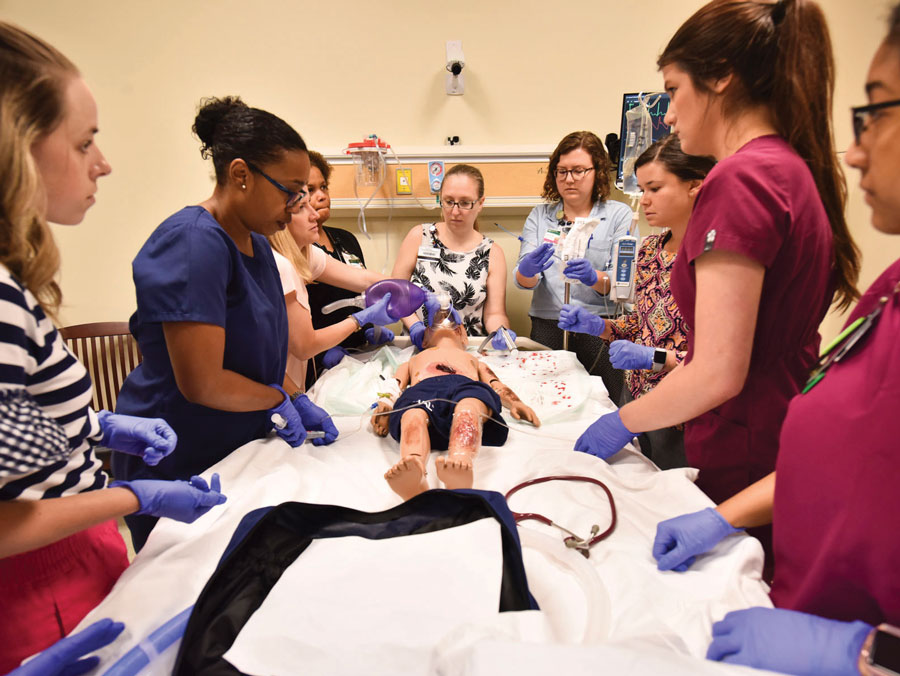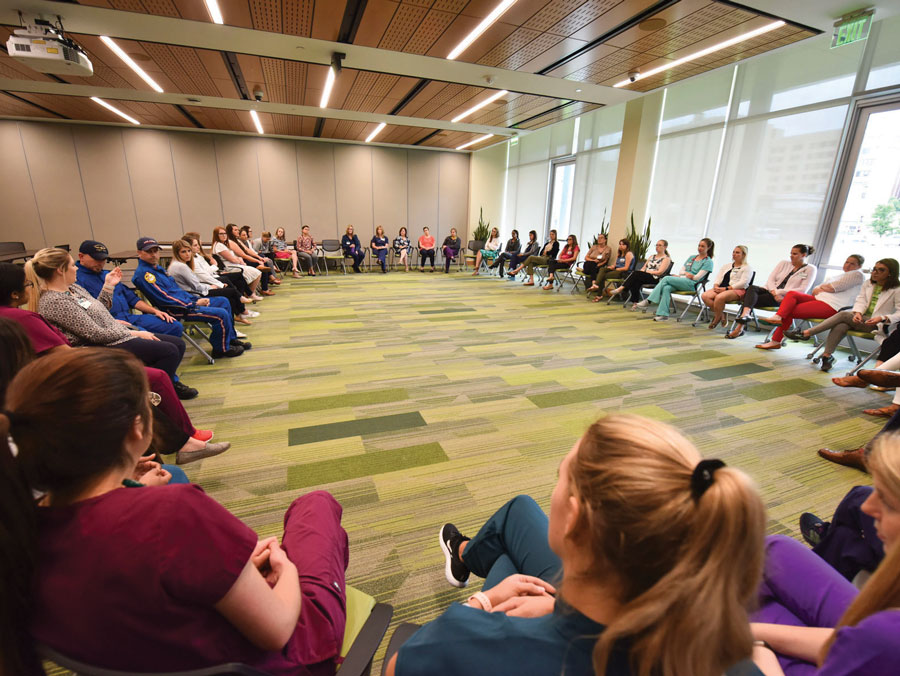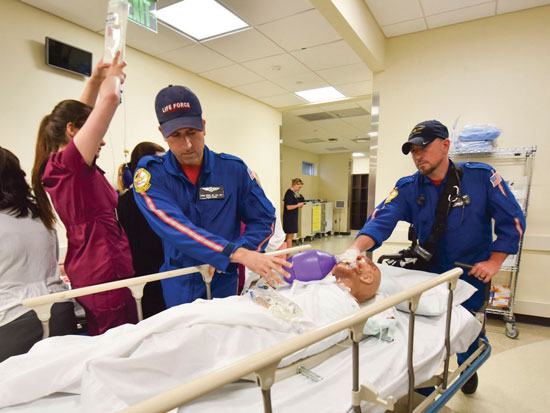There has been a bus crash. Several children are injured, and due to overcrowding at other area hospitals, some of the victims are coming to UAB School of Nursing.
This is the situation Acute Care Pediatric Nurse Practitioner students faced in an on-campus simulation – 20 minutes of chaos.
In a disaster or mass casualty situation, it’s very important that as a care provider, you know your role and develop it. One of the main purposes of this simulation is for our Pediatric Nurse Practitioner students to learn to triage, delegate, work as a team and collaborate in a disaster situation,” said Assistant Professor Steadman McPeters, DNP, CRNP, CPNP-AC, RNFA.
During the simulation, 30 Master’s of Science in Nursing (MSN) students cared for crash victims, played by UAB SON faculty, staff and family. They encountered amputations, foreign body removal, stitches and other circumstances that are found in real-life disaster scenarios.
“Most of these students have experience as an acute care nurse, but the likelihood of them experiencing a mass casualty event in their clinical rotation is very low,” said Instructor and Dual Pediatric Primary/Acute Care Specialty Track Coordinator Jeremy Jordan, MSN, CRNP, CPNP-AC, CCRN, CNE (MSN 2014). “It’s something we hope they never face, but it’s also something we want to prepare them for. We can use simulation to prepare UAB students, to give them all of the tools to handle clinical experiences that are infrequent, but very high stakes.”
 00:00 Assistant Professor and Director of Clinical Simulation and Training Penni Watts, PhD, RN, CHSE-A (PhD 2015), enters the MSN classroom, alerting everyone of the crash. They rush over to the School’s competency suites, where they find four exam rooms with crash victims. They disperse between patients and begin administering care.
00:00 Assistant Professor and Director of Clinical Simulation and Training Penni Watts, PhD, RN, CHSE-A (PhD 2015), enters the MSN classroom, alerting everyone of the crash. They rush over to the School’s competency suites, where they find four exam rooms with crash victims. They disperse between patients and begin administering care.
01:44 As students assess the victims, they ask questions of faculty already on scene. In the simulation, these faculty members are the nurses and as the nurse practitioners, the MSN students must instruct which steps to take next.
“These students are nurses that work in the acute care setting and have some clinical time, but this experience gives them the opportunity to bring all of their experience together and enter their nurse practitioner role,” said Director of Pediatric Partnerships Tedra Smith, DNP, CRNP, CPNP-PC, CNE (MSN 2004, DNP 2011). “It’s about owning their new role as an NP.”
02:05 Another victim, a teenage male, is rolled into the unit. Some students step away from the current patient and begin to care for the new patient. They assess his needs, asking questions and tending to his wounds.
03:32 In the operating room within the competency suites, students are caring for a crying child. The child, which is a high-fidelity manikin, cries and asks for its mother. All sounds and vital signs are controlled outside of the room through a computer.
05:13 A teenage female has severe lacerations to her leg. Played by a live actor, she is conscious with some other scrapes and bruises, and two students ask questions to assess her state. They determine she needs stitches and begin stitching a moulage cut in her leg.
08:34 Within the new competency suites, students work in separate rooms on their patients. Each room also has a control room, through which high-fidelity manikins and their vital signs can be controlled.
 “The new building brought an additional element of realism into this event,” Jordan said. “Instead of controlling the manikins by standing behind a curtain and speaking, the dedicated control rooms took that element out of the exam room and allowed students to really buy into the simulation.”
“The new building brought an additional element of realism into this event,” Jordan said. “Instead of controlling the manikins by standing behind a curtain and speaking, the dedicated control rooms took that element out of the exam room and allowed students to really buy into the simulation.”
09:22 After a new patient, the bus driver, is rolled into the unit, several nurses rush over to care for him. He is in critical condition and has lost a leg. They must continue chest compressions and use the defibrillator to deliver a shock.
12:18 Students work to stabilize a very young patient, only 7 kilos (14 lbs).
15:30 Flight nurses arrive on the scene and receive a hand-off on the care and condition of an injured patient. They get all of the information they need and wheel the patient away to airlift him to another regional hospital.
17:07 A pregnant mother’s water breaks. She has been wandering through the unit, and after seeing one of her sons injured, begins experiencing labor pains. Students ask each other who has OB and neonatal experience, so that the mother can have the best possible care as labor progresses.
 “We typically have a mother involved in the simulation, but this year we added in the event of her water breaking. Because our students are geared towards pediatric patients, who are aged 0-21, they had to think of the best way to care for an adult patient, and one who needed specialized care,” McPeters said. “When they started asking out loud who had obstetrics experience, they were showing an initiative to find their team members with the right abilities to help her.”
“We typically have a mother involved in the simulation, but this year we added in the event of her water breaking. Because our students are geared towards pediatric patients, who are aged 0-21, they had to think of the best way to care for an adult patient, and one who needed specialized care,” McPeters said. “When they started asking out loud who had obstetrics experience, they were showing an initiative to find their team members with the right abilities to help her.”
20:00 Students are alerted that the simulation has ended, and they can cease care for their patients. Slowly, they step away from the manikins and live patients.
“In the room and in the simulation, it’s amazing to see the expressions on our students’ faces and that sense of accomplishment when things wrap up,” Smith said. “You get to see them come alive in the room.”
After the simulation wraps up, students enter a debriefing conversation about the experience. The debrief allows faculty and students to reflect on the highlights and difficulties of the simulation, and to provide feedback for future practice and future simulations.
“As a pediatric nurse practitioner student who wants to work in an acute care setting, this simulation is definitely something that I could experience in the future,” said MSN student Kelsie Bottiggi. “The ability to experience a mass casualty event in a controlled setting allowed us to work on patient prioritization and closed-loop communication in a stressful situation. In addition to using skills we learned in our program, the simulation allowed us to hone those communication techniques that are beneficial regardless of the area we end up working in.”
